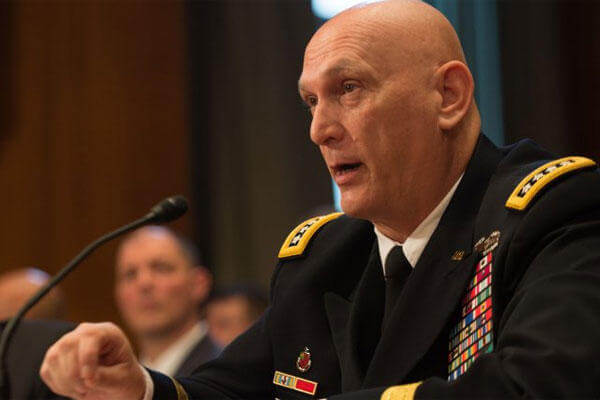The U.S. Army's top officer said he's adamant that American combat troops shouldn't be sent back to Iraq.
The service's departing chief of staff, Gen. Raymond Odierno, whose term ends in September, recently spoke at length about the U.S. military presence in Iraq, where he once led troops in combat.
"I absolutely do not agree right now with us putting U.S. forces on the ground and I am adamant about that and I think it would not be helpful at all," he said during a recent interview with reporters in Washington, D.C.
His comments came a few weeks after a panel of mostly defense hawks testified before Congress that as many as 20,000 U.S. ground troops must be deployed to Iraq to combat Islamic militants gaining ground in the country.
TROOP LEVELS DEBATED
Frederick Kagan, one of the architects of the Bush-era troop surge of additional U.S. forces in Iraq and a former professor of military history at West Point, was among those who cited the higher figure last month during a hearing of the Senate Armed Services Committee on U.S. policy in Iraq and Syria. The panel's chairman, Sen. John McCain, R-Arizona, is a frequent critic of White House policy in the Middle East.
"We need to have a total of 15,000 to 20,000 U.S. troops in Iraq in order to provide the necessary enablers, advisers and so forth," said Kagan, a scholar at the American Enterprise Institute. "Anything less than that is simply unserious."
President Obama last year ordered airstrikes against the Islamic State in Iraq and Syria after militants affiliated with the Sunni extremist group overran parts of both countries and took control of U.S.-supplied military equipment, including weapons and vehicles. ISIS later circulated videos showing the execution of Western prisoners, including the beheading of American aid worker and former Army Ranger Peter Kassig.
Obama has since authorized the deployment of about 3,000 American service members back to Iraq -- after withdrawing all U.S. troops from the country in late 2011. As of Feb. 18, there were about 2,600 American military personnel in Iraq, with most serving as advisers to Iraqi and Kurdish forces in Baghdad and Irbil.
ADVISERS VS COMBAT TROOPS
Odierno, who commanded the 4th Infantry Division during the 2003 U.S.-led invasion of Iraq and later oversaw allied forces in the country, made a distinction between deploying advisers and combat troops.
"I'm fine with embedding advisers," he said. "I'm talking about combat formations. I'm not at all behind -- I'm adamant about not putting combat formations to actually conduct the fighting. But I'm absolutely for -- if the president wants to put more advisers, I think it's something that he'd be willing to do and could make a difference."
On this point, the general and the hawks seem in agreement. At the hearing, John Keane, a retired Army general and former vice chief of staff, said advisers could serve as forward air controllers to direct air power and attack helicopters.
"The war in Iraq is largely close combat, urban warfare, which demands the bombs be guided from our airplanes to the ground by people on the ground," he said. "Seventy-five percent of the sorties that we're currently running with our attack aircraft come back without dropping bombs, mostly because they cannot acquire the target or properly identify the target."
‘INCREDIBLY DISAPPOINTING'
Odierno, who was confirmed as the Army's chief of staff in 2011 and plans to retire after his current term ends in September, said he was most optimistic about the future of Iraq in 2010 after the so-called surge of more than 20,000 additional U.S. troops helped to restore security in and around Baghdad.
"The violence in Iraq was at the lowest levels it had been," he said. "We saw the economics were starting to grow -- oil was being exported at a higher rate. I felt very good about Iraq and I felt that we were absolutely on the right track."
But the Shiite-led government in Baghdad remains at odds with Sunni, Kurd and other minority groups.
"They have not been able to overcome the mistrust that they had between sects, whether it be Sunni, Shia, Kurd, Kurd-Arab, Persian-Arab," Odierno said, "and it continues to significantly degrade what we had set up. I'll be frank; it's incredibly disappointing to me personally what I've watched happen ... They've fallen apart."
MISSTEPS IN IRAQ
The general also reflected on some of the early U.S. missteps in Iraq, such as the disbanding of the Iraqi army after the fall of Saddam Hussein, a move that he said he opposed early on.
"I was very clear in 2003-04 -- no, we shouldn't have," he said. "I think we should have cleansed it of those who were obviously with Saddam Hussein. But I think there was enough -- it's like everything else, they might have been part of the Baath party but were they really? Everybody had to be part of a Baath party to survive. And we could have done a lot better job of sorting through that and keeping the Iraqi army together. And I think we struggled for years to try to put it back together again."
While he said it's hard to predict what might have happened in Iraq under another scenario, Odierno said keeping the Iraqi army largely intact may have encouraged Iraqis to work together politically and allowed the U.S. military to leave the country far earlier.
"We struggled for years to try to put it back together again," he said. "We've always struggled with the leadership and I think that's part of what's playing out and continues to play out."
-- Brendan McGarry can be reached at brendan.mcgarry@military.com































